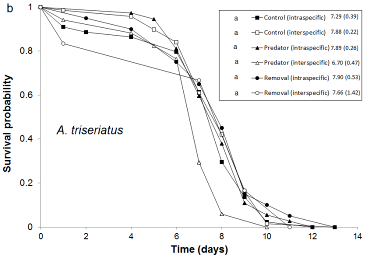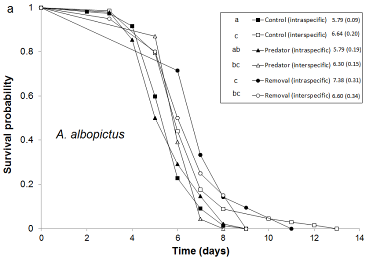Barry Alto: Current Research
1) Emergence and Risk Prediction for Florida of Chikungunya virus
Native to Africa, the first signs of chikungunya virus emergence in Indonesia, and possibly the Americas, date back to the 18th century. Major epidemics in the Indian Ocean began in 2005-2006, later spreading to parts of Europe, and most recently (2013) to the Caribbean, South America, and Central America. These outbreaks represent large geographic expansions, including temperate regions not previously associated with chikungunya virus transmission, raising the concern about chikungunya fever in the U.S. Current research is investigating interactions between multiple lineages of chikungunya virus and invasive mosquito vectors Aedes aegypti and Aedes albopictus. This research involves both empirical studies and the development of transmission models with collaborators
 |
 |
| Preliminary data suggest that Florida A. aegypti have substantial barriers to transmission (midgut infection barrier, salivary gland transmission barrier) for chikungunya virus from the Caribbean. Florida A. aegypti does not appear to be highly competent for an isolate of chikungunya virus from the Caribbean which may limit transmission. |
2) Effects of larval competition on vectorial capacity parameters of dengue vectors
| This project involves laboratory and field tests of hypotheses for effects of inter- and intra-specific larval competition on some of the components of vectorial capacity for populations of the Yellow fever mosquito Aedes aegypti and Asian tiger mosquito Aedes albopictus from regions with and without recent history of dengue transmission |
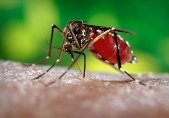 |
| |
Yellow fever mosquito Aedes aegypti (photo credit: CDC/Prof. Frank Hadley Collins, Dir., Cntr. for Global Health and Infectious Diseases, Univ. of Notre Dame). |
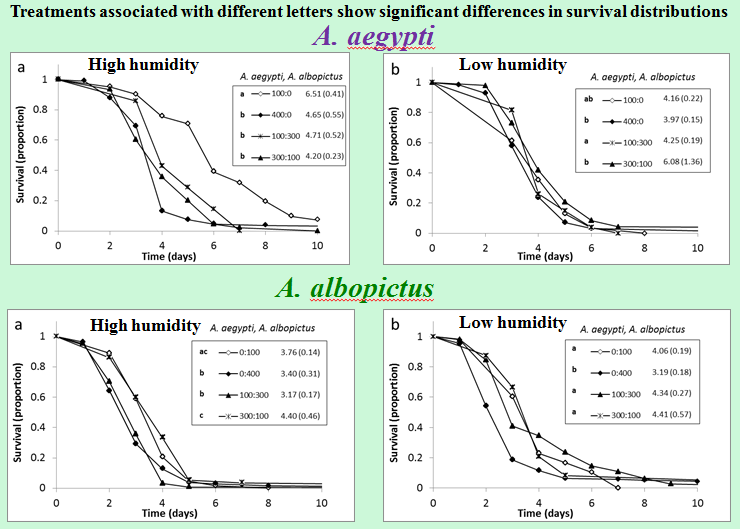 |
| For A. albopictus, intraspecific but not interspecific competition usually reduced adult survival under low and high humidity regimes. For A. aegypti, both intraspecific and interspecific competition reduced adult survival. A. albopictus adult survival was minimally influenced by interspecific competition with A. aegypti, consistent with observations that A. albopictus is the superior competitor. (numbers in the figure legends refer to the initial larval densities) (Alto et al. 2015) |
3) Density and trait-mediated effects of predation in a mosquito community
Container mosquitoes (Aedes triseriatus, A. aegypti, A. albopictus) and a predatory mosquito Toxorhynchites rutilus or predatory midge Corethrella appendiculata are used as model systems to investigate interplay of density and trait-mediated effects in a community, and how effects produced by species interactions among larvae are transferred across life cycle stages as trait-mediated effects on adults.
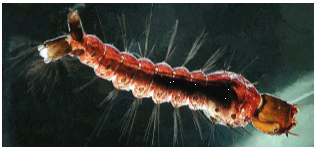 |
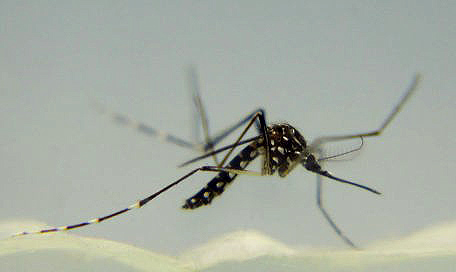 |
|
Toxorhynchites rutilus larva (photograph by University of Florida, Michele M. Cutwa-Francis)
|
|
| Yellow fever mosquito Aedes aegyptiadult (photograph by University of Florida, Michele M. Cutwa-Francis) |
|
| Survival (proportion) of a) A. albopictus and b) A. triseriatus adult females. For A. albopictus, there was a significant interaction between predator and intra and interspecific competition treatments. We simulated the thinning effect of predation according to daily mortality schedules using a prey removal treatment. Thus, we exclude trait mediated effects attributable to the presence of predatory midge C. appendiculata (e.g., changes in prey behavior). Treatments followed by different letters are significantly different from one another. Numbers in the figure legends indicate mean (±SE) lifespan in days (Alto et al. 2012). |
4) Evolutionary consequences of selection in constant and variable environments in an RNA virus
Constant environments are often assumed to favor the evolution of specialization whereas exposure to changing environments may favor the evolution of generalists. We explore the phenotypic and molecular changes associated with evolving an RNA virus in constant versus fluctuating temperature environments. We used RNA virus vesicular stomatitis to determine whether selection at a constant temperature entails a performance trade-off at an unselected temperature, whether virus populations evolve to be generalists when selected in deterministically changing temperature environments, and whether selection under stochastically changing temperatures prevents evolved generalization, such as by constraining the ability for viruses to adaptively improve (e.g., Alto et al. 2013).
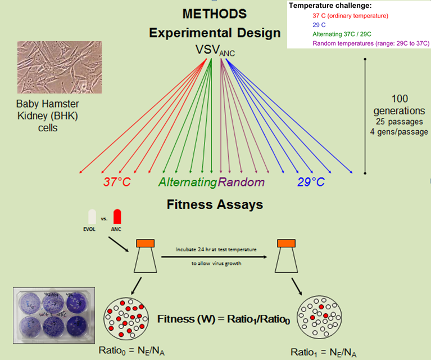 |
|
An experimental evolution approach is used to study adaptation to constant and variable temperature environments.
|
|
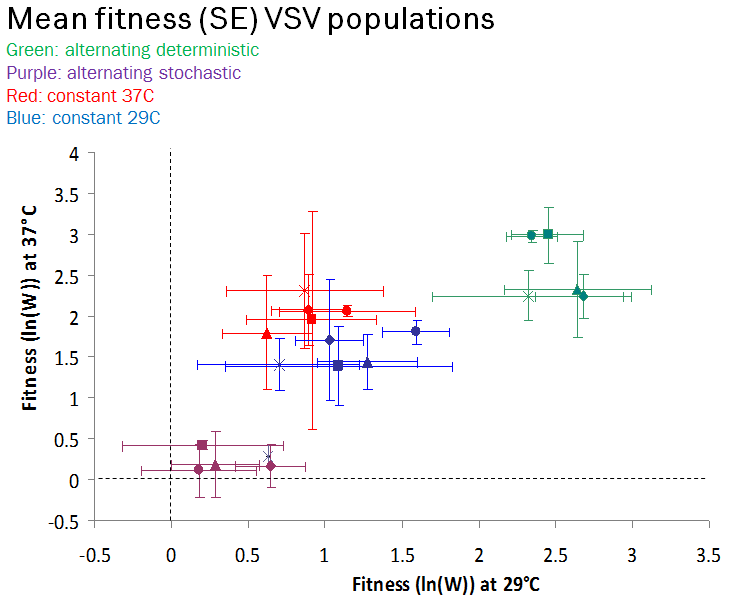 |
|
All VSV lineages evolved at constant temperatures showed fitness gains in their selected temperature with little evidence for trade-offs in performance in the unselected environment. Evolution in deterministically and stochastically changing temperatures led to populations with the highest and lowest overall fitness gains, respectively.
|
|






